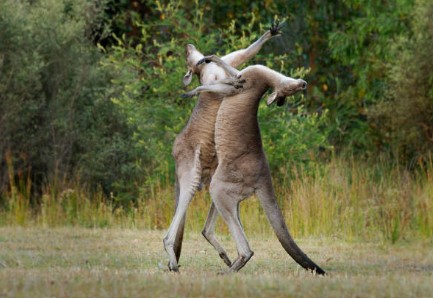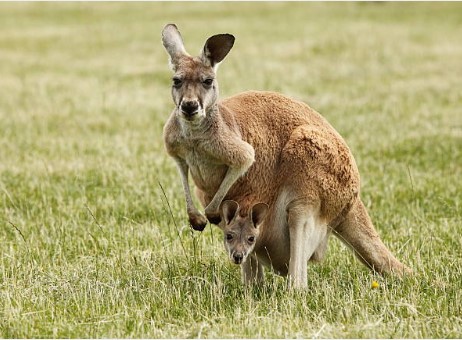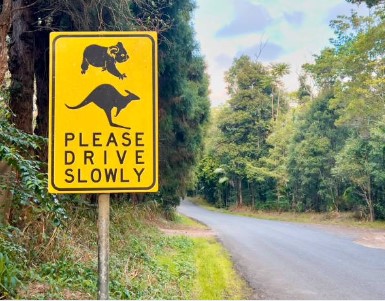
What are Kangaroos?
Kangaroos are fascinating animals.
They’re native to Australia and known for their powerful hind legs and adorable joeys.
Scientific name of kangaroo? The most common species is the Red Kangaroo, scientifically known as Macropus rufus.
Kangaroos are herbivores, so they mainly eat grasses, leaves, and other plant materials. They have a complex stomach to help digest tough vegetation. Kangaroos are the large grazing animals of the Australian continent, the native equivalent of the cows, antelope, and sheep found in Africa, Eurasia, and North America. Their teeth have a resemblance to those of rabbits, and they use these teeth for clipping and chewing vegetation – mainly grass, in the case of grey kangaroos, although the details vary among the other species.
Habitation of Kangaroos
Kangaroos are native to Australia and inhabit various habitats, including forests, woodlands, and grasslands. They are mostly diurnal animals and spend their days foraging for food, resting, and socializing. Kangaroos are herbivores and feed on a variety of plants, such as grasses, leaves, and flowers. They are excellent jumpers and can reach speeds of up to 30 miles per hour.
Foods of kangaroos
Kangaroos enjoy eating various types of grasses, leaves, and other plant materials. Some herbs they love to eat include:
1. Grasses: Kangaroos graze on various types of grasses, such as kangaroo grass and wallaby grass.
2. Leaves: They also feed on various types of leaves, like eucalyptus leaves, which are a significant part of their diet.
3. Shoots: Kangaroos love to eat young shoots of plants, which are rich in nutrients and help them meet their dietary needs.
4. Fruits: In some cases, kangaroos may also consume fruits like acacia gum, which is a popular source of food for them.
These herbs and plants provide the necessary nutrients for kangaroos to thrive in their natural habitats.
Are Kangaroos ruminants?
Kangaroos and their relatives ferment roughage in their stomachs. But these are not the multi-chambered stomachs like ruminants. The stomach of kangaroos takes the shape, not of a simple sac, but of a wide, somewhat elongated, tube. The oesophagus enters into the tube forming a blind-ending sac, while the rest typically curves around through the upper abdomen before emptying into the small bowel at the other end. Muscles are arranged in three strips (technically called “taeniae”) along the length of the stomach.
The stomach has a progressive series of short bulges along its length. The point of this seems to allow the food to pass along the stomach in a conveyor-belt manner, rather than being mixed up together, as it would be in most other animals with a single-chambered stomach.
The majority of the stomach ferments the feed, just as the first three chambers of a cow’s stomach. The blind-ending mainly to absorbs soluble carbohydrates, while the bulk of the tube deals with the roughage.
Only once the food reaches the last section of the stomach is it actually exposed to gastric juices. So that part acts like a cow’s fourth stomach.
This arrangement is less efficient than the full set-up of four or even the three-chambered stomach. Food passes through the gut more quickly, but, that gives the animal less time to extract nutrition from it.
Kangaroos produce far less methane than regular ruminants. The specific kinds of bacteria found in Kangaroos stomach are quite different from those in cows, and likely digest the food in a different way.
They do not chew the cud like true ruminants. Kangaroos are fore-gut fermenters, but are not true ruminants.
The size of kangaroos
Kangaroos come in different sizes depending on the species.
The largest species, the red kangaroo, can grow up to 6.5 feet (2 meters) tall and weigh around 200 pounds (90 kg).
The smaller species, like the musky rat-kangaroo, are much smaller, measuring only about 10 inches (25 cm) tall and weighing around 1 pound (0.5 kg).
Adult kangaroos have long, powerful hind legs, which they use for jumping and getting around.
Their tails are also long and muscular, providing balance and support while jumping. Kangaroos have small, furry forelimbs that they use for grabbing and holding onto objects.
Overall, kangaroos are relatively large animals with unique anatomy and locomotion adapted to their Australian habitat. As far as i know, kangaroo has a very unique reproductive system. Yes, kangaroos have an interesting reproductive system.
Female kangaroos have a uterus with two chambers, called the uterus didelphys. This allows them to carry twins or even triplets, which is quite rare in mammals. Female kangaroos also have a pouch, which serves as a safe place for their joeys to develop and grow. Once the joey is born, it crawls into the pouch and attaches itself to one of the two teats. The joey stays in the pouch for several months, nursing and growing, until it becomes too big for the pouch and starts exploring the outside world.
Male kangaroos, on the other hand, have a different reproductive system. They have a penis bone, called the baculum, which is longer and more robust than in other mammals. This bone helps them maintain their erection during mating.
Overall, kangaroos have an adapted reproductive system that allows them to thrive in their unique environment and ensure the survival of their species.
Reproduction of Kangaroos
The puberty age of kangaroo?
Kangaroos reach sexual maturity and experience puberty at different ages depending on their species and gender.
Generally, female kangaroos reach sexual maturity around 18-24 months of age, while males may take a bit longer, usually maturing between 24-30 months old.
During puberty, female kangaroos will start to produce milk, and their reproductive organs will mature, allowing them to become pregnant.
Males will also experience an increase in testosterone levels, which leads to the development of their muscles and reproductive organs, making them ready for mating.
It’s important to note that kangaroos have different breeding seasons, which can vary depending on their location and species.
In the wild, they often breed during the rainy season when food is more abundant, and the environment is more conducive to raising young.
Mating behavior of Kangaroos?
Kangaroos engage in a unique form of copulation called “boxing.”
Males will stand side by side with the female and use their forearms to push and thrust against each other. The “boxing” copulation can last for several minutes, as males and females continue to push and thrust their forearms against each other.

During the “boxing” copulation, males will ejaculate sperm onto the ground or on the female’s back. The female then transfers the sperm to her reproductive tract through licking and grooming.
Is there any courtship before mating?
Yes, there is courtship before mating in wallabies. Males will perform a “boxing” ritual with females, pushing and thrusting their forearms against each other to establish dominance and show interest. This can last for several minutes. Males perform a “boxing” ritual with females to establish dominance and show their readiness for mating. They may also vocalize and lick the female’s face.
How they select their partner?
Males compete with each other through the “boxing” ritual to establish their dominance and increase their chances of mating with available females.
Gestation period of kangaroos
The gestation period for kangaroos is relatively short compared to other mammals, lasting around 30-35 days.
Female kangaroos have a unique reproductive system that allows them to become pregnant again while already carrying a joey in their pouch. This process is called embryonic diapause, and it helps ensure that the joey in the pouch doesn’t compete with the newborn for resources. After giving birth, the joey will crawl into its mother’s pouch, where it will continue to develop and grow for several more months. The newborn joey is tiny and undeveloped, relying on its mother’s milk for nourishment.

As the joey grows, it will gradually move further back in the pouch, eventually occupying the space closest to its mother’s body.
This close contact helps the joey regulate its body temperature and keep warm, as kangaroos are not well adapted to cold environments.
Liter size of Kangaroos
Kangaroos typically have a very large litter size, with some species giving birth to up to three joeys at once! However, twins are more common, and the mother’s pouch can accommodate them both. Say something about their estrus cycle. Kangaroos have a unique estrus cycle, with females only being fertile for a short period of time. This occurs around every 33 days, and mating can happen anytime during this period.
Life span of kangaroo
The average lifespan of a kangaroo can vary depending on the species, but in general, they can live for around 20 years in the wild and up to 30 years in captivity. Some species, like the red kangaroo, have a shorter lifespan of around 10-15 years in the wild. Factors that can affect a kangaroo’s lifespan include predation, disease, and access to food and water.
In the wild, they must constantly adapt to changing environmental conditions and face various challenges to survive.
In captivity, with proper care, nutrition, and veterinary attention, kangaroos can live longer and enjoy a better quality of life.
Social behavior
In the wild, kangaroos are generally not social with humans. They are shy, solitary animals that prefer to live in groups called mobs or troops, depending on the species. These groups can range from a few individuals to hundreds of kangaroos.
However, in captivity, kangaroos can become accustomed to human interaction and may even form bonds with their caretakers. They are often kept in zoos or wildlife sanctuaries, where they receive proper care and attention from experienced staff. In these settings, kangaroos can learn to trust humans and interact with them under controlled conditions.
In the wild, it’s important to remember that kangaroos are wild animals and should be respected from a safe distance. It’s not advisable to approach or interact with them without proper guidance or supervision.
Are Kangaroos dangerous animal?
Kangaroos are generally not dangerous animals, especially when compared to larger predators like lions or bears. They are herbivores and prefer to avoid confrontation. However, kangaroos can be unpredictable and may defend themselves if they feel threatened or if their joeys are in danger.
They have powerful hind legs and strong tails that can deliver powerful kicks and swings. In rare cases, kangaroos may bite if provoked or if they feel trapped.
As with any wild animal, it’s important to respect their space and not approach them too closely. If you encounter a kangaroo in the wild, it’s best to observe from a distance and let them go about their business.
In captivity, kangaroos are usually well-adjusted and used to human interaction, but it’s still important to follow safety guidelines and listen to the instructions of zoo staff.
Does Australian people eat kangaroo meat?
It’s a popular source of lean protein and is considered an environmentally friendly alternative to beef, as kangaroos are not raised on farms and don’t require as much land or resources as cattle. Kangaroo meat is often marketed as a healthier, lower-fat option.
How much meat an average kangaroo produce?
An average adult kangaroo can produce about 15 to 25 kg (33 to 55 lbs) of meat. The exact amount can vary depending on the species, age, and gender of the kangaroo.
Are kangaroos endangered animals?
Unfortunately, some kangaroo species are facing threats and are considered endangered.
Suggestions to protect them
There are several ways to protect kangaroo populations and their habitats:
1. Support conservation organizations: Donate or volunteer with groups that work towards kangaroo conservation.

2. Reduce your carbon footprint: Lowering your consumption of fossil fuels and supporting renewable energy sources can help protect habitats and ecosystems.
3. Be mindful of your purchases: Avoid buying products made from endangered species or that contribute to habitat destruction.
4. Educate others: Share your knowledge and passion for kangaroos with friends, family, and your community.
5. Advocate for policy changes: Encourage lawmakers to enact legislation that protects kangaroo habitats and reduces threats to their survival. By working together and taking action, we can make a positive impact on kangaroo conservation.
